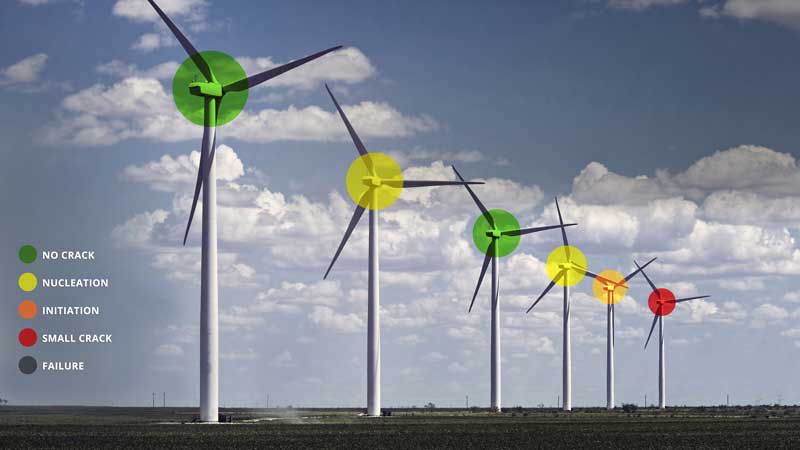Bearings are the microprocessors to rotating equipment, and yet they cause 65% of gearbox failures. The reason? The ability to predict when bearing failures will occur is very difficult to do. It’s even more challenging to understand failures early enough to make life extension decisions (actions that keep the asset healthy).
Bearings have a long propagation to failure, meaning damage within the materials may take years to reach to the surface. However, once pitting or spalling occurs, the failed bearing begins wreaking havoc on the system.
Bearing performance is complex and may vary based on operating conditions. Loading events, lubrication type, surface treatment type and the unpredictable nature of weather, can all contribute to premature bearing failures.
In wind energy, for example, one wind turbine at the same site may experience different operating conditions than another of the same class. Therefore, one gearbox fails prematurely, and the other doesn’t.
For these reasons, roller and ball bearings have been dubbed “the nemesis” of diagnostic solutions on the market. Condition Monitoring Systems and Big Data solutions available promise to solve bearing failures and enable life extension, but lack the understanding necessary to detect failures before they are imminent. Once a sensor alerts the operator to a problem within the turbine, it’s too late to take preventative actions. Failure has already propagated. Similarly, big data solutions analyze historical events to create patterns that are deterministic in nature. Users adopt Planned Preventative Maintenance (PPM) techniques that attempt to mitigate catastrophic and unplanned failures, but this proactive approach can lead to over-servicing, with components being serviced and/or replaced prematurely. Site managers struggle with getting ahead of costly corrective maintenance procedures, and therefore crave ways to move away from PPM and corrective maintenance strategies, and instead move to Predictive Health Maintenance (PHM) techniques that enable life extension.
Sentient Science’s software is differentiated from other data analytic solutions by its materials science approach to computational testing. DigitalClone® took 10 years to build, four years of additional validations in several test markets and NASA’s validation in 2010, but today the world’s largest wind operators and suppliers around the world are using the software platform for its prognostics and life extension value.
The software combines materials science, tribology, multi-body dynamics and operational data to provide a “3D watchlist” of the current health state and future life of each major component and critical subcomponent for each asset on a site and/or in a fleet.
As a trusted third party to the operator, Sentient Science works with both the operators and original equipment manufacturers (OEM) to build DigitalClone models within the software platform. The Buy on Life aspect of the software provides supplier/OEM comparisons based on the life impact and lifecycle cost impact the product offerings have on field assets. The operator chooses the right configuration for life extension, resulting in a reduction in costs of up to 13% of revenues.
When operators know the budgets and aftermarket part forecasts of their fleet today, tomorrow, 3+ years from now, they can not only prevent repeat failures in their fleet, but they can negotiate long-term servicing and replacement contracts with their suppliers that help control costs.
DigitalClone Live was invented with $30 million of Small Business Innovative Research (SBIR) funding support from the world’s largest operator, and Sentient’s oldest customer, the Department of Defense. Sentient Science continues to partner with the DoD in yearly SBIR grants that continually enhance and expand the capabilities of DigitalClone.
Digitalization of industrial equipment is changing the way the world operates and buys heavy machinery. Computational testing with materials science unlocks a new way of testing rotating equipment and predicting the true operational life. Software enables unlimited trade off studies and simulations under load, resulting in 1000s of data points and more reliable, safer machinery and components.
While physical testing is still important, it comes with time, budgetary and parameter constraints. Today, equipment operators and OEMs are investing in advanced technologies to enhance their current physical testing solutions to achieve 40% reductions in cost and up to 75% reductions in schedules.
To learn more, request a demo below.
